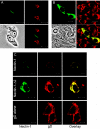Deletion of the second immunoglobulin-like domain of nectin-1 alters its intracellular processing and localization and ability to mediate entry of herpes simplex virus
- PMID: 15731277
- PMCID: PMC1075719
- DOI: 10.1128/JVI.79.6.3841-3845.2005
Deletion of the second immunoglobulin-like domain of nectin-1 alters its intracellular processing and localization and ability to mediate entry of herpes simplex virus
Abstract
Nectin-1 is an immunoglobulin (Ig)-like entry receptor for herpes simplex virus (HSV). Like other nectins, nectin-1 forms dimers and mediates cell adhesion through interactions with other nectins. We constructed a second-domain deletion mutant of nectin-1 (nectin-1-Delta2) to examine the role of the second Ig-like domain in HSV entry. Nectin-1-Delta2 exhibited a severely reduced ability to mediate HSV entry and accumulated in the endoplasmic reticulum but retained the ability to interact with its HSV ligand, gD. The failure of nectin-1-Delta2 to mediate HSV entry probably resulted from its failure to be transported to a membrane targeted by HSV for viral entry.
Figures




Similar articles
-
Use of chimeric nectin-1(HveC)-related receptors to demonstrate that ability to bind alphaherpesvirus gD is not necessarily sufficient for viral entry.Virology. 2001 Jul 5;285(2):366-75. doi: 10.1006/viro.2001.0989. Virology. 2001. PMID: 11437670
-
Contributions of gD receptors and glycosaminoglycan sulfation to cell fusion mediated by herpes simplex virus 1.Virus Res. 2001 Apr;74(1-2):39-45. doi: 10.1016/s0168-1702(00)00244-6. Virus Res. 2001. PMID: 11226572
-
Structural features of nectin-2 (HveB) required for herpes simplex virus entry.J Virol. 2001 Nov;75(22):11185-95. doi: 10.1128/JVI.75.22.11185-11195.2001. J Virol. 2001. PMID: 11602758 Free PMC article.
-
Different receptors binding to distinct interfaces on herpes simplex virus gD can trigger events leading to cell fusion and viral entry.Virology. 2006 Jan 5;344(1):17-24. doi: 10.1016/j.virol.2005.09.016. Virology. 2006. PMID: 16364731 Review.
-
The novel receptors that mediate the entry of herpes simplex viruses and animal alphaherpesviruses into cells.Rev Med Virol. 2000 Sep-Oct;10(5):305-19. doi: 10.1002/1099-1654(200009/10)10:5<305::aid-rmv286>3.0.co;2-t. Rev Med Virol. 2000. PMID: 11015742 Review.
Cited by
-
Novel mutations in gB and gH circumvent the requirement for known gD Receptors in herpes simplex virus 1 entry and cell-to-cell spread.J Virol. 2013 Feb;87(3):1430-42. doi: 10.1128/JVI.02804-12. Epub 2012 Nov 14. J Virol. 2013. PMID: 23152509 Free PMC article.
-
A soluble form of human nectin-2 impairs exocrine secretion of pancreas and formation of zymogen granules in transgenic mice.Biochem Biophys Rep. 2015 Dec 10;5:196-202. doi: 10.1016/j.bbrep.2015.12.006. eCollection 2016 Mar. Biochem Biophys Rep. 2015. PMID: 28955824 Free PMC article.
-
Herpes virus fusion and entry: a story with many characters.Viruses. 2012 May;4(5):800-32. doi: 10.3390/v4050800. Epub 2012 May 10. Viruses. 2012. PMID: 22754650 Free PMC article. Review.
-
Herpes B virus utilizes human nectin-1 but not HVEM or PILRα for cell-cell fusion and virus entry.J Virol. 2012 Apr;86(8):4468-76. doi: 10.1128/JVI.00041-12. Epub 2012 Feb 15. J Virol. 2012. PMID: 22345445 Free PMC article.
-
The Ig-like v-type domain of paired Ig-like type 2 receptor alpha is critical for herpes simplex virus type 1-mediated membrane fusion.J Virol. 2010 Sep;84(17):8664-72. doi: 10.1128/JVI.01039-10. Epub 2010 Jun 23. J Virol. 2010. PMID: 20573830 Free PMC article.
References
-
- Cocchi, F., M. Lopez, L. Menotti, M. Aoubala, P. Dubreuil, and G. Campadelli-Fiume. 1998. The V domain of herpesvirus Ig-like receptor (HIgR) contains a major functional region in herpes simplex virus-1 entry into cells and interacts physically with the viral glycoprotein D. Proc. Natl. Acad. Sci. USA 95:15700-15705. - PMC - PubMed
-
- Cocchi, F., L. Menotti, P. Mirandola, M. Lopez, and G. Campadelli-Fiume. 1998. The ectodomain of a novel member of the immunoglobulin subfamily related to the poliovirus receptor has the attributes of a bona fide receptor for herpes simplex virus types 1 and 2 in human cells. J. Virol. 72:9992-10002. - PMC - PubMed
-
- Fabre, S., N. Reymond, F. Cocchi, L. Menotti, P. Dubreuil, G. Campadelli-Fiume, and M. Lopez. 2002. Prominent role of the Ig-like V domain in trans-interactions of nectins. Nectin3 and nectin 4 bind to the predicted C-C′-C"-D beta-strands of the nectin1 V domain. J. Biol. Chem. 277:27006-27013. - PubMed
-
- Geraghty, R. J., A. Fridberg, C. Krummenacher, G. H. Cohen, R. J. Eisenberg, and P. G. Spear. 2001. Use of chimeric nectin-1(HveC)-related receptors to demonstrate that ability to bind alphaherpesvirus gD is not necessarily sufficient for viral entry. Virology 285:366-375. - PubMed
Publication types
MeSH terms
Substances
Grants and funding
LinkOut - more resources
Full Text Sources
Molecular Biology Databases
Miscellaneous

